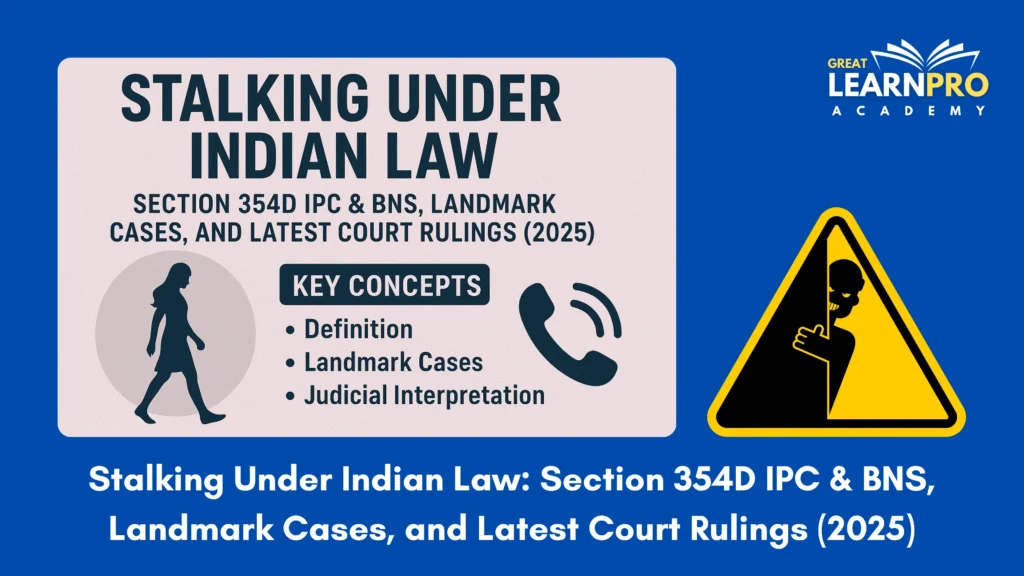
Stalking, as a legal concept, emerged in Indian criminal law relatively recently with the introduction of Section 354D of the Indian Penal Code (IPC) through the Criminal Law (Amendment) Act, 2013. This amendment was made in the aftermath of the Nirbhaya case of 2012, which brought renewed attention to the safety of women and the need for specific provisions addressing harassment.
Under Section 354D IPC, stalking is defined as the act of a man who follows a woman and contacts or attempts to contact her repeatedly despite her clear indication of disinterest, or monitors her use of the internet, email, or any other form of electronic communication. However, the provision also includes certain exceptions where such conduct may not amount to stalking, such as if it is pursued for preventing or detecting crime, or when it is undertaken under any lawful duty.
Landmark Judicial Precedents on Stalking
Over the years, Indian courts have interpreted stalking in various contexts, providing greater clarity on its scope:
- Shankar @ Nandu v. State of NCT of Delhi (2012) – Though decided before Section 354D was enacted, this case highlighted the growing concern over repeated harassment of women in public spaces, laying the foundation for recognizing stalking as a distinct crime.
- Karthik v. State of Kerala (2016) – The Kerala High Court emphasized that mere friendship proposals or attempts to converse do not amount to stalking unless they cross the threshold of persistent and unwanted conduct against a woman’s wishes.
- Manoj Bajpai v. State of Madhya Pradesh (2019) – The Madhya Pradesh High Court clarified that stalking under Section 354D includes both physical following and virtual harassment, recognizing the dangers of cyberstalking.
- Vishal Kumar v. State of Himachal Pradesh (2020) – The Himachal Pradesh High Court held that continuous calling and messaging of a woman against her will falls within the purview of stalking, even if no physical following occurs.
These cases collectively demonstrate that stalking is not limited to physical pursuit but includes technological and digital harassment as well.
Recent Himachal Pradesh High Court Judgment: Photographing a Woman is Not Stalking
A particularly significant development in the interpretation of stalking came from the Himachal Pradesh High Court in Krishna Kumar Kasana v. State of Himachal Pradesh and Anr (2025), where the Court examined whether taking photographs of a woman without her consent constitutes stalking.
Facts of the Case
The petitioner, was charged under Section 221, 224, 351(2) and 78 of BNS after allegedly taking photographs of a woman without her permission. The informant argued that such an act amounted to stalking, as it intruded upon her privacy and dignity. It was contended that the mere act of clicking photographs without consent created fear and amounted to harassment. The petition was for pre arrest bail as the petitioner was to be in custody for interrogation for the above mentioned charges
Issues Before the Court
- Does taking a photograph of a woman without her consent amount to “stalking” under Section 354D IPC?
- Can such conduct, in the absence of repeated following or attempts to contact, fall within the statutory definition of stalking?
Court’s Reasoning
The High Court carefully analyzed the statutory text of Section 78. It observed that stalking requires the element of “repeated following” or “continuous attempts to contact” despite disinterest. The Court noted that photographing a person may raise concerns of privacy violation, but it does not automatically amount to stalking unless coupled with persistent pursuit or harassment.
The Court distinguished between the offence of stalking and other possible offences under the BN, such as voyeurism, which explicitly deals with capturing images of women engaged in private acts. In this case, the act of taking a photograph in a public space, though objectionable, did not meet the ingredients of stalking.
Judgment
The Himachal Pradesh High Court held that the mere act of taking a photograph of a woman, without more, does not constitute stalking under Section 78 of BNS. The Court granted bail to the petitioner of the charge under this section but emphasized that such conduct might be actionable under other legal provisions if it amounts to an invasion of privacy or causes mental trauma.
Conclusion
Stalking under Section 78 of BNS remains a vital protection for women against repeated harassment, both in physical and digital spaces. Landmark judgments across states have expanded its meaning, balancing individual freedom with the right to dignity and privacy. The recent Himachal Pradesh High Court judgment in Krishna Kumar Kasana v. State of Himachal Pradesh and Anr (2025) reaffirms that the offence of stalking requires persistence and continuity, and that isolated acts, like taking a photograph, may not amount to stalking unless accompanied by further harassment. Going forward, legislative clarity and judicial consistency will be essential in ensuring that the law protects women without over-criminalizing actions that do not meet the statutory threshold.
Sources:
- https://www.livelaw.in/high-court/himachal-pradesh-high-court/himachal-pradesh-high-court-rules-taking-woman-photos-not-stalking-301133
- https://devgan.in/bns/section/78/?utm_
More Current Affairs: https://learnproacademy.in/updates/

Fantastic beat I would like to apprentice while you amend your web site how could i subscribe for a blog site The account helped me a acceptable deal I had been a little bit acquainted of this your broadcast offered bright clear concept
I wanted to take a moment to commend you on the outstanding quality of your blog. Your dedication to excellence is evident in every aspect of your writing. Truly impressive!
Hi my family member I want to say that this post is awesome nice written and come with approximately all significant infos I would like to peer extra posts like this